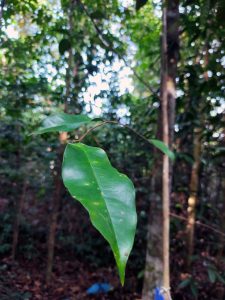18
Karas - Aquilaria malaccensis Lam. - Thymelaeaceae[1]
Other names:
Gaharu, depu, engkaras[1]
General information:
Large buttressed tree to 50 m tall; lowland forest; Pk and Tg southward.
Distinguish botanical characteristics:
Big trunk, tall (up to 40m) circum. 80cm, shining leaves surface, pointy & oval like Spanish Cherry[1].
Uses:
Malay: To treat various conditions such as weakness, pain in the stomach or chest, oedema and as tonic for men and women as well as post partum medicine [4]
Mainly used in religious ceremonies and prayers, as a form of healing or medication, essence of parfum and grooming or hygiene purposes. Due to its aromatic fragrance, gaharu ( when burned ) is much favoured by Taoist, Buddhists, Hindus and other faiths and in certain cultures. such as the Japanese, whom also used it not only in anti-emetic treatment to relieve and alleviate vomiting, nausea, tranquilizer indigestion complaints and meditation [2] .The Chinese have long used it to treat renal and lungs illness, stomach aches, diarrhea. The European and Indians has used it in the formulation of medication for cancer treatment. The East Asians have long used it as an expensive parfum extracts attar oil apart as well as for shampoos and soaps[3].
Major/bioactive phytochemicals:
Unknown
References:
[1] Mohd Fauzi et al., (2017). Journal of Academic Research in Business and Social Sciences 7(4 ): 1021-1029. ISSN: 2222-6990
[2] Okudera, Y., & Ito, M. (2009). Plant Biotechnology, 26(3), 307–315. http://doi.org/10.5511/plantbiotechnology.26.307.
[3] Barden et al. (2000). Heart of the Matter: Agarwood use and trade and CITES implementation for Aquilaria malaccensis, 1–52.
[4] Nor Azah et al.,(2008).The Malaysian Journal of Analytical Sciences, 12(2): 338 – 340
SK & SZMS, 2022


